

A global archive of independent reviews of everything happening from the beginning of the millennium
To send us a review you have written click here
Read our Copyright Notice click here
For publication dates click here
The Journal d'une Femme de Cinquante Ans is now not much read and is out of print (and out of copyright) but an ebook version in the original French is available at Project Gutenberg.
*****
At the Coronation of King Charles III, the state coach left for Westminster Abbey with six horses and the gold state coach that returned to Buckingham Palace did so with eight.
If he had been crowned an emperor as well it could have been sixteen.
The television shots of it returning up the Mall in procession was like a lovely take on the eighteeenth century and the twenty-first together, with elements of both.
As for the Lord President of the Council, Penny Mordaunt, carrying the sword of state, it had tinges of antiquity to it, a fashion must-copy.
BERLINE WITH SIX HORSES
Reviewed by ANDRE BEAUMONT
The Journal d'une Femme de Cinquante Ans (or Recollections of the Revolution and Empire in the English translation) by the Marquise de la Tour du Pin is a much raided source book for those writing about the ancien regime, the Revolution or the Napoleonic era though it was not published till about a century after the events described, in 1906.
Biographies like these, published at a safe distance in time from events, were probably like pure escapism for some readers, especially before motion pictures. If you know the history then you also know what is going to happen and it is just a question of how the heroine or hero is going to navigate the sudden fluctuations of fortune and how they relate to the other players in this great drama. The mere existence of a biography almost always means one is reading about a successful survivor of tumultuous events so a sufficiently happy ending is likely. The formula is a bit like a thriller in which you already know some of the supposed villains but drawn from real life.
The 'journal' of the marquise de Henriette Lucie Dillon de la Tour du Pin de Gouvernet is not a political biography. Politics appear not to interest her and she more than once disowns wishing to write history so omits the background events and concentrates on high society. You are expected to fill in the historical gaps from your own knowledge.
History, though, cannot do without her and the raids upon her are for quotes about the societies in which she lived and the high society (as the Emperor observed: "Vous n'aimez que celle-la") she always sought to place herself in.
She can, however, be raided solely for her observations on fashion over 40 years, which are more like cameos than full portraits, and that is what this review attempts to do.
Mademoiselle Dillon makes her first long journey at thirteen years of age in 1783:
We set out in a large berline with six horses. My uncle and my grandmother were seated in the back, with myself and the secretary of my uncle facing them, and two domestics on the box seat in front.
She already has a good eye for the costume of both men and women (later we come across her making her own dresses, shirts for servants and so on so she was more than an observer) and we get a view of episcopal privilege during the ancien regime (her great-uncle was Archbishop of Narbonne and presided over the States of Languedoc):
At Palud my uncle changed his costume. He put on a wadded costume of violet cloth, lined with silk of the same colour; silk stockings, also violet in colour, shoes with gold buckles; his cordon bleu, and a three-cornered hat ornamented with gold tassels.
As soon as the carriage had passed the large arch of the bridge at Pont-Saint-Esprit, the cannon of the little citadel at this bridge-head fired twenty-one shots. The drums beat a salute, the garrison came out, the officers in full dress, and all the civil and religious authorities presented themselves at the door of the berline. If it was not raining, my uncle descended while they attached the eight horses destined for his carriage.
Note the change in the number of horses at this point. Later she describes Napoleon arriving in Bordeaux in a berline with eight horses.
In the eyes of the inhabitants of Languedoc the President of the States was a much greater man than the King. My uncle was extremely popular. Although he was very haughty, his arrogance was never shown except to those who were, or thought they were, his superiors.
This, of course, is a good recommendation. She herself sees things clearly and describes people's good and bad qualities, though rarely in the same paragraph.
In Languedoc I had a servant attached to my person who was at the same time my coiffeur. He wore my livery, which we were obliged to have in red, although in England it was in blue, because our stripes were exactly the same as those of the House of Bourbon. If our costumes had been blue, our livery would have been exactly the same as the King's, which was not allowed.
She has an ancien regime directness, although she is writing much later, and is particularly proud of some things including her position in society, her hair and her figure:
To return to myself. I was then what would be called from every point of view a good match, and since I am on the subject of my personal advantages, I think this is the place to trace my portrait. It will not be very attractive on paper, because I owed my reputation for beauty only to my figure, my general appearance and not at all to my features.
I had a mass of light blond hair; small grey eyes, with very few eyelashes, most of which I had lost through a severe attack of smallpox at the age of four; I had thin blond eyebrows; a high forehead, and a nose which was said to be Greek, but which was too long and too large at the end. My finest feature was my mouth, with very fresh lips, chiselled like those of an antique statue, and beautiful teeth which I have preserved intact at the age of seventy-one. It was said that my face was agreeable, that is had a gracious smile, and, notwithstanding all this, I could be considered plain. However, a large and beautiful figure and a clear and transparent complexion, with a great deal of colour, gave me a marked superiority in all gatherings, especially by day, and it was certain that I outshone many women apparently endowed with superior advantages.
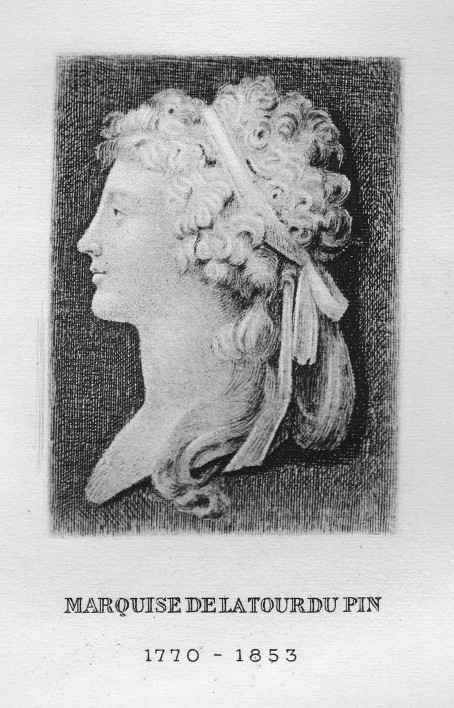
She marries the Comte de Gouvernet in 1787. Modern curiosity would be directed to her marriage dress but she gives little space to it:
Let us not forget the toilette of the bride, which was very simple. I had a dress of white crepe, trimmed with Brussels lace. As veils were not then in vogue, I wore pinners, that is to say, a head-dress having long flaps hanging down the sides of my cheeks. I had a sprig of orange blossom on my head and a bouquet at my side.
Certainly, it is less important than her dress for presentation at court:
I was in full court dress (grand corps), that is to say with corsage expressly made, without shoulder straps, laced in the back, but so narrow that the lacings, four fingers wide at the bottom, revealed a chemise of the finest batiste. This chemise had very short sleeves and no straps, as to leave the shoulders bare. The top of the arm was covered with three or four rows of white lace falling to the elbow. The neck and shoulders were were entirely uncovered. Seven or eight strands of large diamonds, which the Queen had wished to lend me, partially concealed my own. The front of the corsage had the appearance of being laced with rows of diamonds. I also had a number on my head in the form of an aigrette.
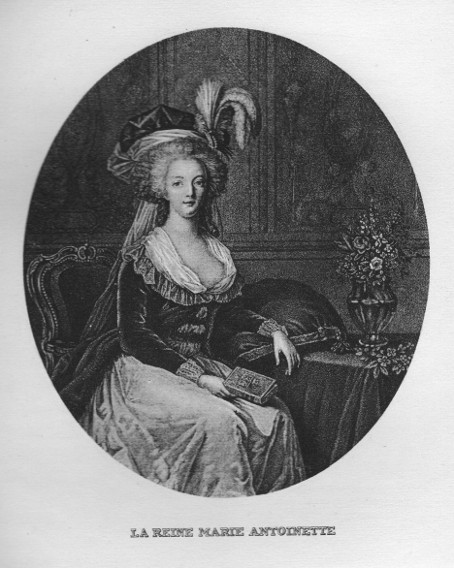
By the eve of the Revolution we have no doubt of her fashion sense. She attends a ball where she is a fashion rebel:
I think it was during the spring of the year 1789 that the Duke of Dorset, the English Ambassador, who had just been replaced by Lord Gower and his charming wife, Lady Sutherland, gave a fine ball on the eve of his leaving Paris. At the bottom of the invitations he had placed very cavalierly: "Les Dames seront en blanc." This order displeased me. By way of protest, I ordered a charming robe of blue crepe, trimmed with flowers of the same colour. My gloves and my fan were also adorned with blue ribbons. In my coiffure, aranged by Leonard, were blue feathers. This piece of childish folly had a great success. Everyone kept remarking: "Oiseau blue, couleur du temps." The Duke of Dorset himself was amused at this pleasantry and said that the Irish were pig-headed!
If you want to be terrified by the Revolution in all its stages you have only to read this journal. Especially compelling is her eye-witness account of the invasion of Versailles by a mob whilst her husband, Monsieur de la Tour du Pin, is second-in-command of the troops there. (She views Monsieur d'Estaing, in command, as useless).
For long periods they have to go into hiding seperately. At one point she has to hide in an isolated spot in the Haut-Brion vineyards:
It was isolated in the midst of a vineyard surrounded on three sides by parish roads leading in different directions, and on the fourth side by an extensive moor. No village was to be found in the environs, and all this part of the country, called Haut-Brion, comprised an agglomeration of properties, planted with vines and almost all contiguous.
Needing to escape to America, it is that legendary figure of the Revolution, Theresia Cabarrus, then Mme de Fontenay and later Mme Tallien, resident at Bordeaux, who facilitates their escape.
There is a description of her:
Mme de Fontenay was then not more than twenty years of age. A more beautiful human being had never issued from the hands of the Creator. She was a perfect woman. All her features bore the imprint of the most regular and artistic perfection. Her hair, black as ebony, seemed made of the finest silk, and nothing detracted from the brilliancy of her complexion which was as clear as ivory. An enchanting smile displayed the most admirable teeth. Her tall form recalled that of the Diane Chasseresse.

There is also a description of Tallien:
I raised my eyes to look at this monster whom I had not regarded. Before me I saw a man of twenty-five or twenty-six, with a fine face he endeavoured to render severe. A mass of blond curls escaped from all sides under a large military hat covered with varnished cloth and surmounted by a tricolored plume. He was dressed in a long tight overcoat of coarse blue cloth, over which hung a sabre by a shoulder belt which was crossed by a long silk scarf of the three colours.
She has got the dress sense to be good at disguises. A one point she sends her husband a peasant's costume. Likewise, to get a passport to leave France:
On account of the English or American name I wished to take, I was dressed as a lady, but very badly gotten up and wearing an old straw hat.
Her sojurn near Albany as a kind of settler farmer of 250 acres is one of the most interesting parts of the book and much later she is preceded 'by a kind of romantic reputation which I owed to my adventures in America'.
Though she and her husband were never inscribed on the list of exiles, one of the people she encountered in America who had been was Talleyrand of whom there is this moral assessment:
I regretted sincerely to find so many reasons for not holding him in my esteem, but I could not avoid forgetting my disagreeable recollections when I had passed an hour listening to him. As he had no moral value himself, by singular contrast, he had a horror of that which was evil in others. To listen to him without knowing him, you would have believed he was a worthy man.
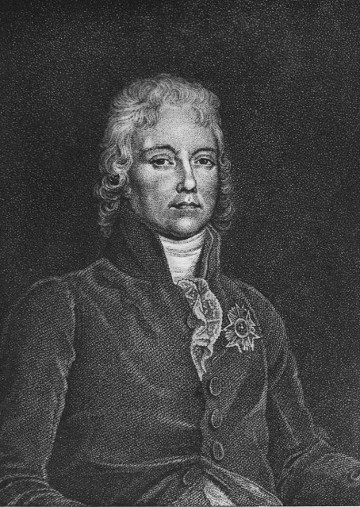
Talleyrand
In America she dresses in the local vernacular:
One thing had rendered me at once very popular with my neighbours. The day that we took possession of our farm, I adopted the costume worn by the women of the neighbouring places, that is to say, a skirt of blue and black striped wool, a little camisole of light brown cotton cloth, a hankerchief of the same colour, with my hair parted as it is worn now, and caught up with a comb. In winter, I wore gray or blue woollen stockings, with moccasins or slippers of buffalo skin; in summer cotton stockings, and shoes. I never put on a dress or corset, except to go into the city. Among the effects which I had brought to America were two or three riding-costumes. These I used to transform myself into a dame elegante, when I wished to pay a visit to the Schuylers or van Rensselaers, for very frequently we dined and afterwards passed the evening with them, particularly when it was moonlight, and above all, during the period of snow.
They return to Europe via Spain during the Directory and just after landing in Cadiz:
The indiscreet curiosity decided us, my companion and myself, immediately to dress like the Spanish women. Even before proceeding to the inn, we went to purchase black skirts and mantillas so as to be able to go out without scandalizing the whole population.
Eventually they are forced to leave France for England, where she had extensive family, but where they found themselves with very little money.
Of England she writes:
England, where there are fortunes so immense, existences so luxurious, is at the same time the country in the world where poor people can live in the most comfortable manner.
An able horsewoman by her own account she is fascinated by Newmarket which she believes she visited in the early days of October 1797:
We stopped for the night at Newmarket where are held the famous horse-races, which I was very curious to see. We remained here all the next day. It was the last day of the races and the one on which was run the Royal Cup. We passed the whole day upon the turf and by good chance, quite rare in England, the weather was very fine. I have guarded the memory of this day as one of those in my life when I was most amused and interested.
They return to France in the early days of the Consulate. Her half-sister, Fanny Dillon, is the cousin of Mme Bonaparte who
...examined me from head to foot and her attention was particularly drawn to a tress of blond hair which surrounded my head and from which her eyes could not be drawn. As we rose to leave she could not refrain from demanding in a low tone of Mme de Valence if this tress was indeed my own hair.
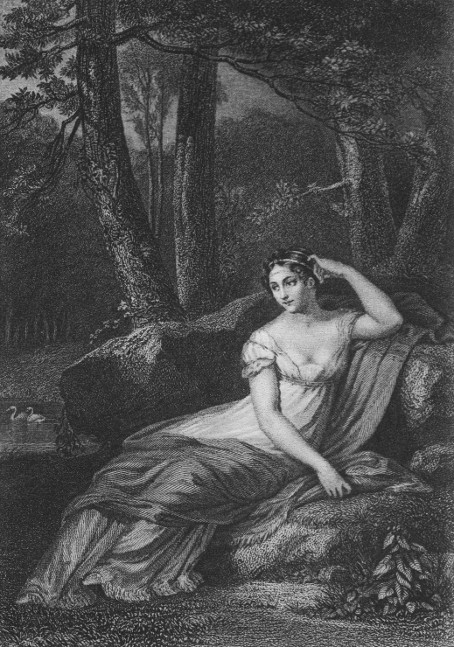
Empress Josephine
She is summoned to an Assembly in Bordeaux by the Emperor but not having a black dress with her and the Court being in mourning she improvises:
Fortunately I had a pretty robe of gray satin. I added several dark ornaments, the good coiffeur arranged some black ribbons in my hair, and this seemed to me very appropriate for a woman of thirty-eight, who can say, without vanity, that she did not have the air of being more than thirty.
There is always the hint that the Emperor talks to her flirtatiously and it has been conjectured elsewhere that her half-sister Fanny, later married to General Bertrand, was his mistress on St Helena.
He fixed his eyes on me, smiling graciously, and when my turn came he said to me laughing, in a familiar tone, when he regarded me from head to foot:
"Why you are not then afflicted over the death of the King of Denmark?"
"Not sufficiently, Sire," I replied, "to sacrifice the pleasure of being presented to your Majesty. I had no black dress."
"Oh that is an excellent reason." And then he added: "You were in the country!"
Everyone being in the Emperor's favour, soon after this her husband is appointed Prefect of Brussels, the Emperor having crossed off someone's name from a list of intended appointments and written in La Tour du Pin.
Napoleon takes Marie Louise as his second empress whom she sketches as lacking the intelligence to be a match for such a great man.
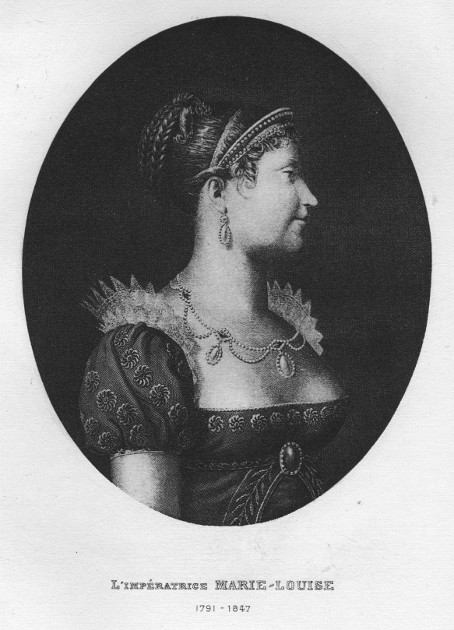
She is invited to an entertainment at the Tuileries:
We assembled in the salon of the Empress. The Emperor came directly to me. With an extreme kindness he spoke first of my son, then he exclaimed regarding the simplicity of my dress, my good taste and my distinguished air, to the great surprise of several ladies covered with diamonds, who were asking each other who this new-comer could possibly be. When we entered the gallery, I was placed on a bench very near that of the Emperor. The play, "L'Avocat Patelin," was performed by some admirable actors. The piece which was very comical amused Napoleon very much and he laughed heartily. The presence of the great man did not prevent me from doing the same. This pleased him very much, as he said afterwards in mocking the ladies who thought it necesary to maintain their gravity.
The memoir continues for another four years to the end of the first restoration but there is relatively little further on costume so we can leave her here on her playful note.
*****
Lionel Edwards' Napoleon, Skirmish with Russian Cossacks, undated
Seen at the British Sporting Art Trust's opening of Seen from the Saddle at the Osborne Studio Gallery, 13 April 2021 (Napoleon's horse here must be Tauris [1] )